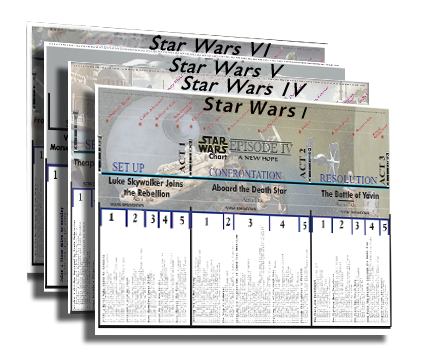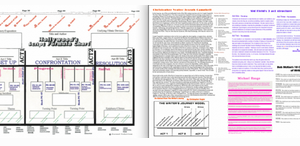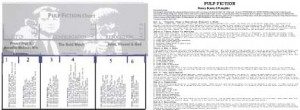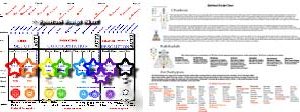Hollywood Script Format Chart
There are standard rules used by all of the Hollywood studios for screenplays. These rules are the clearest, cleanest way to tell a visual story. The Script Chart is a compilation of all these screenwriting golden rules, superimposed on Aristotle’s three act structure. It is also broken down into 10-page sections (what the agents look for in Hollywood) and it is broken down by page number. The areas of importance occur exactly where they should be in the script according to the page numbers at the top; from pages 1 to 120. The front of the chart is the Story Guide and on the back are full color-coded descriptions that match the outline on the front.
The reason this chart is so widely used in the industry is that every possible formula and story outline created for the art of screenwriting is on it and they are all superimposed on the three-act structure. It is a real good idea to make sure your story follows along with at least one of them. Joseph Campbell’s “Hero’s Journey” model teaches the writer the importance of myth in a story and describes the many archetypes the hero encounters on his journey. The 3 Act Structure dates back to Aristotle. Shakespeare developed it further in his plays. Hollywood uses it in practically every film today. It is the backbone of Story.
The HOLLYWOOD SCRIPT FORMAT CHART™ shows you how to create successful stories in perfect script format. This chart describes the ancient power of myth in detail as it applies to all stories in the hero’s journey model. It includes the 10 Commandments of Screenwriting, plot points, hooks, and emotional curves. It also includes the golden paradigm-three act structure, formatting and submission tips, and the page number breakdown.
Pulp Fiction Script Chart
The first “Act” of Pulp Fiction follows a story through VINCE VEGA’s eyes and centers on his relationship with his boss’s wife MIA. He is asked by his boss to take Mia out while his boss is out of town, but he’s aware that his boss almost killed another man for rubbing Mia’s feet. Obviously, this is a touchy situation, but it only gets worse when Vince meets her and starts to like her. They enjoy an intimate meal and return home in a romantic, dancing glow. That’s when Mia mistakes Vince’s heroin for cocaine and overdoses on it while he’s not looking. Vince has to save her or face his deadly boss’ wrath. He returns to his heroin dealer and through desperate measures, they revive Mia and save her life. Vince returns Mia to her house and blows her a kiss goodnight, feeling affection for her that he will never reveal.
The second “Act” follows boxer BUTCH COOLIDGE. Where Vincent Vega was the Main Character, now Butch is. Butch has been asked to take a dive by Marsellus Wallace (in a small scene played out between the two sequences of “Act 1”). Faced with this humiliating request, Butch finds he can’t do it. Instead, he double-crosses Marsellus and tries to escape town with his girlfriend FABIENNE. But Fabienne forgets to pack the one thing that Butch values above all else: his father’s watch. Butch’s daring attempt to retrieve his watch results in a deadly confrontation with Marsellus and finally brings him to an even worse evil hidden in the neighborhood.
The third “Act” would fall chronologically (in terms of the events described in this work) within the first act, between Brett’s execution and Vincent’s date with Marsellus Wallace’s wife. For thematic reasons, however, this “Act” is plucked out of sequence and presented to close this film. Where Vincent was the Main Character of the first Act and Butch Coolidge was the Main Character of the second Act, hitman Jules Winnfield is the Main Character of the third Act. Faced with certain death at the hands of one of the boys he was sent to execute, Jules is shot at six times in close quarters and every bullet misses him. He is deeply affected and believes this has been a sign from God that he must “quit the life” and become an ordinary citizen rather than a criminal. His new resolve is tested by two trials, one involving the disposal of a dead body and one where he becomes the intended victim of an armed robbery. He manages to survive both encounters with his new holiness intact and ends the story fully intending to “quit the life” and “walk the earth like Kung Fu.”
Spiritual Script Chart
Our soul goes through life experiencing the many archetypes of human existence. It watches its story like a movie on a screen. That story is based on divine spiritual formulas that were first discovered ages ago by the great sages and mystics of many religious teachings. The Spiritual Script Chart shows how a great story is developed by a treasury of wisdom hidden deep within our creative consciousness. This chart is like the Hollywood Script Formula Chart using the 3 act structure as the backbone of story. It also brings together a tapestry of new age thought into a new story model incorporating the mind, body, and spirit. It follows along with the 7 key spiritual turning points, superimposed on the seven chakras in the body, the 7 rays, the 7 Earth kingdoms, the 7 archangels, the 7 planes, the Cabalistic tree of life, the seven dimensions of light, color and sound, soul psychology, philosophy, and metaphysics.
This seven stage process of spiritual transformation fits a wide range of the esoteric field. It shows how the structure of myth, Major Arcana, and the archetypes correspond to the seven energy centers in the body. This chart shows the journey, as we travel through each Chakra in the body starting from the root chakra at the base of the spine and move up into the crown chakra. Each Chakra corresponds to a major turning point in the script and a major transformation in the character’s development. The spiritual journey a human being must undergo is analogous to the hero’s journey in a good story. If you are writing a script to send a spiritual message to mankind, to help others transform their lives, or to simply enlighten the whole planet, then this chart is for you.
Star Wars Script Charts
Long ago in a galaxy not so far away, George Lucas made movie history. He blended archetypes of legends and visionary cinema to revolutionize the film industry. The Star Wars films effectively demonstrate the movement of the hero’s journey and show a clear and simple path through the many archetypes the hero encounters. Using the model from Joseph Campbell’s teachings, George Lucas was able to create an entire universe of metaphors, symbols, and myths that express how we feel about good and evil, technology and faith.
Campbell defined the Hero Cycle, a course of events that occurs as a rite of initiation in every myth, pinpointing the need for mentors, villains, elixirs, and jesters along the way. Each step can be traced in the adventures of Star Wars. The Star Wars Saga contains the same mythic structure that the ancient storytellers used to fuel imaginations throughout the ages. To follow this billion dollar formula the main character in your story will need to encounter tests, trials, ordeals, joys, and rewards; then meet all of his/hers shadows, mentors, shapeshifters and threshold guardians.
These charts are each a full color-coded layout of the episode. It includes a detailed scene breakdown description for each act. It includes the hero’s journey model and how it specifically relates to the main character in this episode. The back of the chart includes a complete description of the film in perfect detail: The Introduction crawl, story synopsis, and the breakdown of each scene on the front of the chart in even more detail. Star Wars is a timeless story grounded in mythology like stories from our childhood that draw us in, leave us full of awe and wonder, and compel us to return. The Star wars Saga appeals to the human psyche on all levels which has made it one of the most enduring stories of modern times.




